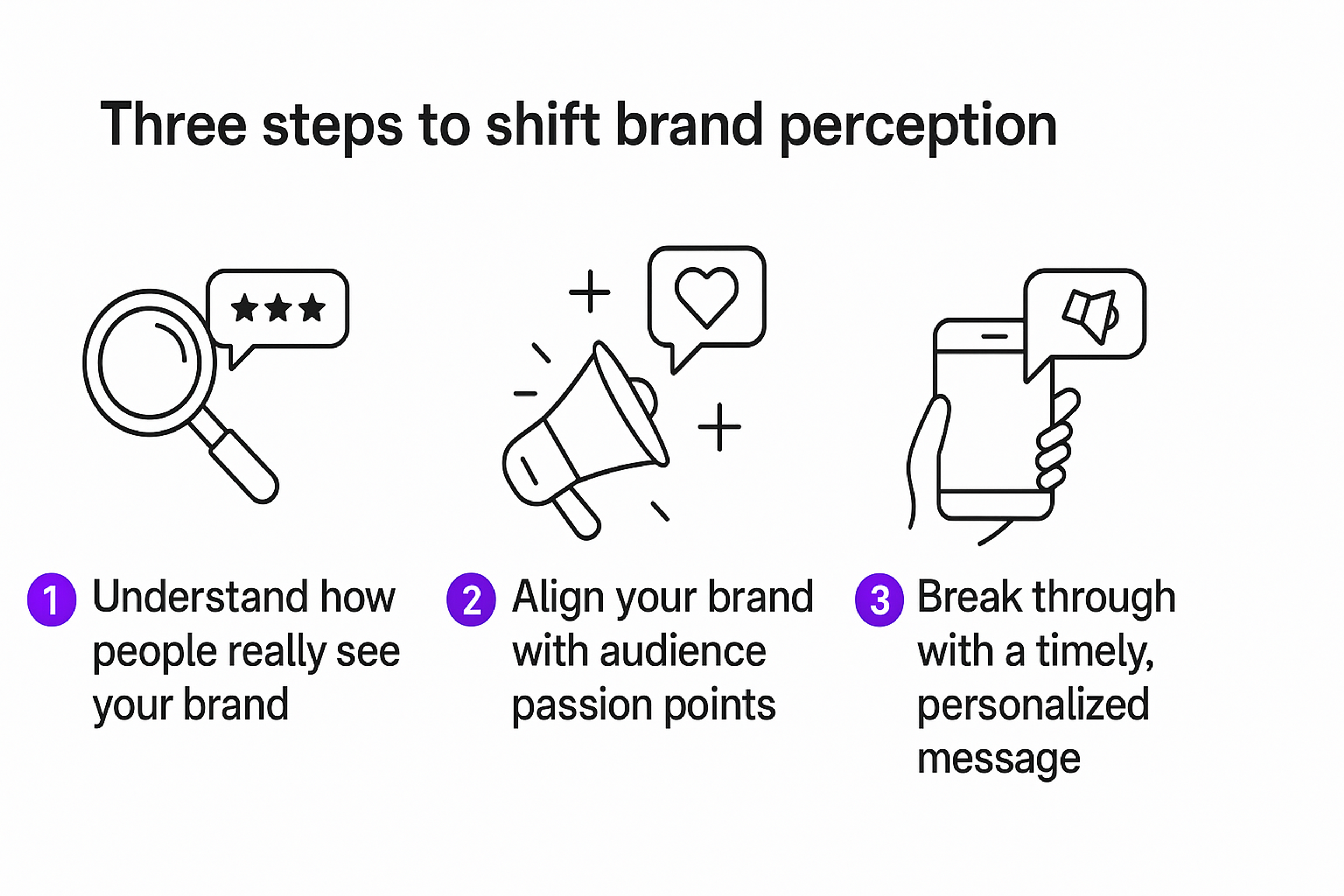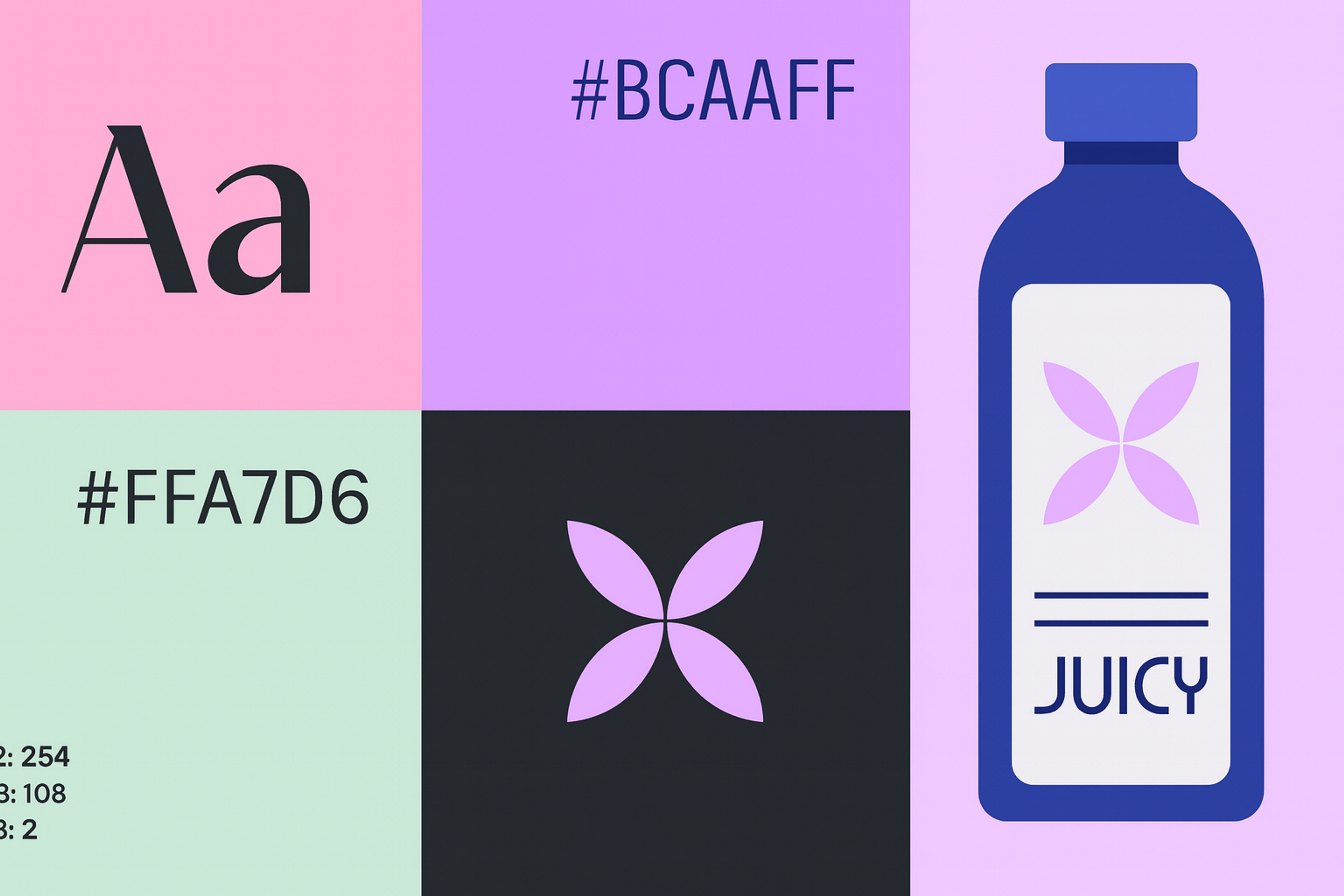Your brand isn’t just your logo or tagline. It also relates to the overall brand perception shaped by public opinion. It’s what people think and feel when they hear your name. That perception can make or break your business.
Shaping brand perception is essential for building a successful business, as it directly influences how customers view and engage with your company.
Building strong positive brand perception helps you attract customers, earn trust, and boost sales. The good news? You can shape how people see your brand using proven strategies. This article reveals the secrets top companies use to create powerful reputations.
What Is Brand Perception?
Brand perception is how customers see your brand based on their experiences, interactions, and customer feedback. It’s the mental image they form from everything you do, from your products to your customer service.
Think of it as your brand’s reputation in the minds of your audience. Their thoughts, feelings, and beliefs about your business shape this perception. Every touchpoint matters: your marketing, your service quality, your social media presence, even how your employees talk about the company.
A consistent brand personality - distinct human traits and characteristics your brand embodies - also plays a key role in shaping how people perceive and emotionally connect with your brand.
The Impact Of Positive Perception

This perception forms through various channels, making it essential to understand brand perception. Advertising campaigns introduce your brand. Word-of-mouth referrals reinforce impressions. Online reviews validate experiences.
Public relations efforts shape narratives. All these elements combine to create the overall image customers hold, including how your brand makes them feel, which is a core part of brand perception.
The Importance of Brand Perception
Good brand perception transforms your marketing. When people view your brand positively, everything gets easier.
Brand perception is important because it directly influences customer confidence, loyalty, and purchasing decisions. A strong perception establishes brand value and equity, setting the foundation for long-term market success.
You gain pricing power. Customers willingly pay more for brands they trust and respect, which is crucial to improve brand perception . Your perceived value rises, letting you command premium prices without losing customers.
Loyalty deepens naturally. People stick with brands they believe in, and positive brand perception is a key driver of increased customer loyalty. They return for repeat purchases and resist switching to competitors. This loyalty translates directly into stable revenue.
Your reputation strengthens over time. Positive perception builds on itself. Satisfied customers become advocates who spread the word. This organic growth costs less than traditional advertising. Additionally, strong brand perception can help your business increase its market share in a competitive environment.
Smart business owners understand that strong branding creates differentiation and contributes to brand equity . In crowded markets, perception separates leaders from followers. It helps you stand out in your niche and attract ideal customers.
But negative brand perception damages fast. Negative reviews and bad experiences drive potential customers away. They choose competitors instead. Without careful management, reputation problems snowball.
Brand Perception

Here’s how to take control, starting with brand perception surveys to gauge public opinion:
- Start with awareness strategies across the channels your audience uses most to understand how customers perceive your brand.
- Deliver exceptional customer service at every interaction. Maintain active communication on platforms where your customers spend time.
- Build genuine relationships with key partners.
- Innovate constantly in your offerings.
- Respond quickly to concerns and complaints with authenticity.
These actions compound over time. Each positive interaction strengthens your reputation. Customer confidence grows. Trust deepens. Your brand becomes the obvious choice.
How to Measure Brand Perception?
You can’t improve what you don’t measure. Understanding how customers view your brand starts with gathering feedback and measuring brand perception using various methods.
A brand perception survey is a key tool for evaluating how your brand is seen by your audience.
Surveys give you quick insights into customer opinions. Ask about product quality, service experiences, and overall impressions. Keep questions focused and easy to answer.
The responses reveal patterns in how people perceive your brand. Survey design is crucial for accurate insights, as it affects the quality and reliability of the data you collect.
Focus groups offer deeper understanding. Small group discussions let you explore nuanced feelings and attitudes. You can probe into why customers feel certain ways.
This qualitative data adds context to survey numbers. These methods help develop a genuine understanding of customer perceptions. Brand perception research can also be used to compare attitudes toward your brand and competitors.
When conducting surveys and focus groups, include prospective customers and non customers in your research for a broader view of brand perception.
Social media provides real-time feedback. Track how people engage with your content. Monitor likes, comments, shares, and retweets. These interactions show what resonates with your audience. Pay attention to sentiment in comments and mentions.
Customer reviews deliver unfiltered truth. People share genuine experiences, both positive and negative. These reviews influence potential customers directly. They also highlight specific areas needing improvement.
How to Build a Brand Perception?
Understanding Your Target Audience
Knowing your audience transforms your strategy. The better you understand them, the stronger your brand perception becomes.
Start by researching needs, interests, and buying behavior to see how customers perceive your brand. This knowledge lets you customize communication and marketing. You’ll speak directly to what matters most to them.
Choose the right channels based on where your audience spends time. Younger audiences live on social media and mobile apps. They expect fast, visual content. Older audiences often prefer traditional channels like email, print, and television. Meeting people where they are makes your message more effective.
Beyond channel selection, focus on relationship building. Engaging with your customer base is essential to foster loyalty and build a positive brand reputation. Personalized interactions matter. Respond to customer questions quickly. Offer helpful suggestions without pushing sales. Provide support that actually solves problems.
Three Steps to Shift Brand Perception

Monitor social media to gauge sentiment. What are people saying about your brand? What issues come up repeatedly? Use these insights to improve your offerings and communication.
Address concerns and complaints urgently. How you handle problems often matters more than the problems themselves. Quick, empathetic responses turn frustrated customers into loyal advocates.
Build trust through consistency. Show up regularly with valuable content and genuine engagement. This sustained effort pays off in deeper relationships and stronger loyalty.
Understanding your audience isn’t a one-time project. People change. Markets evolve. Keep learning about your customers throughout your relationship. The insights you gain will continually strengthen your brand perception.
Defining Your Brand Identity
Your brand promise and identity set the foundation for everything else. Without clarity here, your perception efforts scatter in too many directions.
- Start with your mission. Why does your company exist? What problem do you solve? Get crystal clear on your purpose before moving forward.
- Define your core values. What principles guide your decisions? What do you stand for? These values should shine through in everything you do.
- Identify what makes you different from competitors. Every market has crowded spaces. Your unique qualities help you stand out. Maybe it’s your approach, your expertise, your service model, or your culture. Own what makes you special.
- Create visual elements that reflect your identity. Your logo should be memorable and appropriate. Choose colors that convey the right feeling. Select fonts that match your personality. Develop taglines that stick in minds.
Consider the Interos brand refresh as an example. They redesigned their identity while keeping their core essence intact. The new logo featured clean shapes, vibrant colors, and dynamic typography. They created pattern systems reflecting their data analysis expertise.
Every design element reinforced their mission of trust and security in global supply chains. Rebranding efforts like this can significantly improve a brand's image, helping to shape positive perceptions and strengthen reputation in the market.
Interos Identity by Clay
Crafting Compelling Brand Messaging
Your message carries your identity to the world. Make it clear, authentic, and emotionally resonant.
Write in simple, straightforward language. Avoid jargon and complex terminology. Most people don’t want to decode your message. They want to understand quickly what you offer and why it matters.
Align your message with your values. Every piece of communication should reflect what you stand for. This consistency reinforces your identity and builds recognition.
Connect emotionally with your audience. Facts inform, but emotions persuade. Show how you improve lives. Highlight transformations you enable. Paint pictures of better outcomes. Creating emotional connections is essential for shaping positive brand perception and building customer loyalty.
Use storytelling to make your message memorable. Stories stick in minds far better than bullet points. Share customer success stories. Explain your origin story. Illustrate your impact through real examples. Sharing your brand’s history and values through storytelling can foster a strong emotional connection with your audience.
Research your audience deeply before crafting messages. What challenges do they face? What goals do they pursue? Speak directly to their specific situation. Generic messages get ignored. Tailored messages get attention.
Create multimedia content to increase engagement. Videos, images, infographics, and interactive elements catch eyes and hold attention. Different formats appeal to different learning styles.
Focus on channels where your audience actually spends time. Don’t spread thin across every platform. Concentrate effort where it generates results. Quality beats quantity in messaging.
Keep your authentic voice throughout. Don’t try to sound like someone you’re not. People detect insincerity quickly. Be genuinely yourself, and you’ll attract the right customers naturally.
Brand Identity Example

Establishing a Consistent Brand Experience
Consistency builds recognition and trust. Every customer interaction should reinforce the same core message and feeling. Delivering an exceptional customer experience at every touchpoint shapes brand perception and helps build lasting loyalty.
Your brand experience spans multiple touchpoints. Website visits, social media interactions, customer service calls, in-store visits, email communications - each one matters. Quality should remain high across all channels.
Develop clear guidelines for customer interactions. How should your team handle questions? What tone should they use? How quickly should they respond? These standards ensure everyone delivers similar experiences and positively influence customers perception of your brand.
Train employees thoroughly and continuously. They need to understand your brand values deeply. They should know how to embody those values in their daily work. Regular training keeps standards high even as your team grows.
Empower your team to solve problems creatively within your brand framework. Rigid scripts feel robotic. Give people room to bring authentic personality while staying true to your values.
This balance creates memorable positive experiences. Customer engagement at every level plays a crucial role in building these positive brand experiences and fostering emotional connections.
Keep visual elements consistent everywhere. Your logo, colors, fonts, and design style should look the same across digital and physical platforms. This visual consistency helps people recognize you instantly.
Visual Design Elements by Clay

Leveraging Social Proof and Influencers
People trust other people more than they trust companies. Social proof harnesses this reality to strengthen your brand perception. Loyal customers, driven by emotional connections, are more likely to recommend your brand to others, amplifying positive word-of-mouth.
- Social proof works through imitation. When potential customers see others enjoying your products, they want to join in. This psychological principle drives many purchasing decisions.
- Display customer reviews prominently. Authentic testimonials from real users carry enormous weight. They provide third-party validation that your marketing claims alone cannot achieve.
- Share ratings across your platforms. High ratings signal quality and satisfaction. They reduce perceived risk for new customers considering your offerings.
- Collect and showcase testimonials strategically. Video testimonials feel especially authentic. Written reviews work well too. Feature diverse customers to help various segments see themselves in your success stories. Highlighting quality products and perceived quality in these testimonials can further enhance trust and credibility.
- Partner with influencers carefully. Choose people whose audiences align with your target market. Their endorsement introduces your brand to potential customers who trust their judgment. It's important to understand how your brand compares to other brands and competing brands in your industry, as influencer partnerships can shape these perceptions.
- But authenticity matters more than reach. Micro-influencers with smaller, engaged audiences often deliver better results than celebrities with millions of followers. Look for genuine fit over vanity metrics.
- Create clear, consistent communication guidelines for influencer partnerships. They should understand your brand values and represent you accurately. Misaligned partnerships damage more than they help.
- Encourage user-generated content. When customers share their experiences organically, it creates powerful social proof. Repost their content with permission. Celebrate their success stories. Customer use and real experiences directly influence brand perception, making this content especially valuable.
- Engage actively with your community. Respond to comments and mentions. Show appreciation for positive feedback. Address concerns respectfully. This visible engagement demonstrates you value your customers beyond their purchases.
- Use social listening tools to understand broader conversations about your brand. Track mentions, sentiment, and trends. This insight helps you amplify positive perceptions and address negative ones quickly.
Monitoring and Responding to Feedback
Feedback shows you what’s working and what needs improvement. How you handle it shapes your reputation.
Track both positive and negative reviews actively. Positive feedback shows your strengths. Negative feedback reveals problems needing attention. Both provide valuable insights for growth.
Use social media monitoring and Google Alerts to track online conversations and brand mentions, ensuring you stay informed about what is being said about your business across platforms.
Look for patterns in feedback. If multiple customers mention the same issue, it signals a systemic problem. Address root causes, not just individual complaints.
Set clear response time expectations. Customers appreciate knowing when they’ll hear back. Fast responses show you care. Even if you can’t solve everything immediately, quick acknowledgment matters.
Be professional and courteous in all responses. Stay calm even when customers aren’t. Your public responses show everyone how you handle problems. Grace under pressure builds trust.
Brand Perception Factors

Personalize your responses. Generic copy-paste replies feel dismissive. Address specific concerns directly. Use names. Show you actually read and understood the feedback.
When mistakes happen, own them honestly. Apologize sincerely. Explain what you’ll do differently. Follow through on promises. This accountability strengthens relationships rather than damaging them. Unresolved issues can lead to negative perception and a negative reputation, which can be difficult to repair and may impact customer trust.
Celebrate positive feedback too. Thank customers for kind words. Share their success stories. Show appreciation for loyalty. This reinforces positive experiences and encourages more.
FAQ
What Is Brand Perception Meaning?
Brand perception is how people see, feel, and think about your brand based on their experiences, marketing, and word of mouth.
How To Create Brand Perception?
Build consistent visuals, tone, and experiences. Deliver on promises, engage authentically, and collect feedback to shape how people view your brand.
How Important Is Brand Perception?
It’s crucial - it directly impacts trust, loyalty, and purchase decisions. A positive perception turns customers into advocates.
How To Check Brand Perception?
Use surveys, social listening, sentiment analysis, and reviews to understand how audiences describe and feel about your brand.
Read more
Conclusion
Building strong brand perception takes time and consistent effort. But the results - increased trust, loyalty, and growth - make it worthwhile.
Start by understanding your audience deeply. Define your identity clearly. Craft authentic messaging. Deliver consistent experiences. Leverage social proof. Monitor and respond to feedback actively.
These strategies work together to shape how people see your brand. Each element reinforces the others. Over time, positive perception compounds into lasting competitive advantage.
Ongoing brand perception research helps you gauge attitudes and adapt your strategy, while building a strong market presence ensures your brand remains visible and relevant in a competitive landscape.
Don’t wait for perception to happen by accident. Take control of your brand story today. Your future success depends on the reputation you build right now.


About Clay
Clay is a UI/UX design & branding agency in San Francisco. We team up with startups and leading brands to create transformative digital experience. Clients: Facebook, Slack, Google, Amazon, Credit Karma, Zenefits, etc.
Learn more

About Clay
Clay is a UI/UX design & branding agency in San Francisco. We team up with startups and leading brands to create transformative digital experience. Clients: Facebook, Slack, Google, Amazon, Credit Karma, Zenefits, etc.
Learn more


